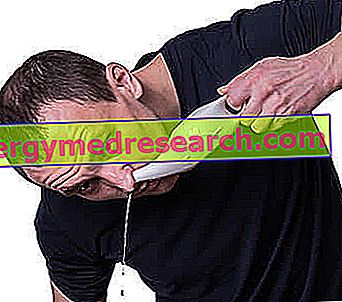Generality
Nasal washing is a practice that involves the passage of saline solutions inside the nose cavities, for hygienic or therapeutic purposes.

The passage of the liquid in the nasal cavities fluidifies the excess secretions, allowing a better drainage, in addition to removing the impurities of the air inhaled, such as dust, allergens and pathogens. The saline solutions also have the power to humidify the inside of the nostrils, giving relief in the case of respiratory problems.
Nasal washes can be performed with a needle-free syringe or with ready-to-use packs, available at the pharmacy.
Indications
Washes allow the nose to be cleansed, contributing to the elimination of allergens, dust, pollutants, bacteria and viruses.
The passage of saline solutions also favors greater patency of the nostrils, improving breathing and increasing the humidity of the mucous membranes.
Nasal washes are indicated for daily hygiene in children, especially in children who have not fully mastered blowing their nose. The practice can be useful for those who work indoors, especially in the presence of dust or dry weather.
In addition to contributing to normal daily hygiene, nasal washes are a natural remedy useful in active prevention and treatment of:
- Rhinosinusitis;
- Cold;
- Respiratory allergies;
- Bronchitis;
- Asthma.
In this sense, this practice assists or represents an effective alternative to typical decongestant drugs used to reduce obstruction of the nasal airways.
Nasal washes are also indicated to alleviate the following symptoms:
- Closed nose;
- Sense of pressure on the nasal sinuses;
- Halitosis;
- Cough;
- Itching and itching of the nose;
- Scab formation;
- runny nose;
- Sore throat;
- Tendency to snore (snoring).
Furthermore, nasal washes help prevent the occurrence of complications in the respiratory tract and secondary infections in the auditory tract (such as otitis).
Mechanisms of action
- Nasal washes clean the mucous membrane of the nose through a mechanical effect . This action allows the removal of impurities from the air (such as allergens) and excess mucus, especially during respiratory tract infections. This promotes and accelerates the healing of inflammatory processes.
- Nasal washes help restore the defensive function of the mucous membrane of the nose, compensating or favoring mucociliary transport . Through this physiological mechanism, the secretions produced daily by the nose and paranasal sinuses are conveyed towards the throat and eliminated through the digestive tract.
During inflammation and allergic reactions, mucociliary transport is significantly reduced, thus promoting the accumulation of mucus and the development of an infection. In this case, nasal washes are useful, as they reduce congestion, draining excess fluids from the mucous membranes and preserving the natural functioning of the nasal cavities.
- Nasal washes also have a eutrophic effect, as they favor the natural regeneration of the mucous membrane of the nose.
Mode of use
Nasal washes can be performed with a needle-free syringe containing at least 20 ml of physiological solution. There are also ready-to-use devices (available in pharmacies) in the form of vials or sprays with physiological or isotonic solution.
Method
- Approach the sink, bend your head forward and rotate it to one side (the head should be positioned lower than the shoulder level), then breathe open-mouthed;
- Place the syringe or nasal washing device at the entrance of a nostril, pointing it towards the ear of the same side;
- Close the same nostril with a finger and irrigate with the solution (empty the syringe inside the nasal cavity, exerting a continuous and slow pressure on the piston or dispense the spray through the special spout for 1 or 2 seconds);
- The solution will usually come out of the opposite nostril, dragging the secretions with it; if the position is correct, the liquid does not reach the throat and does not cause discomfort;
- After washing, tilt the head forward for a few seconds and let the residues of the washing solution drip from the nose;
- Repeat the same operation for the opposite nostril;
- Gently blow the nose (one nostril at a time), keeping the mouth closed.
What solution?
The solutions indicated for nasal washes can be:
- Isotonic, like the physiological solution ; it has a sodium chloride content of about 9 grams / liter. The isotonic solutions respect the physiology of the nasal mucosa and help to restore its natural protective function.
- Hypertonic, like sea water ; has a concentration of salts higher than that of the nasal cells (note: the amount of salt is on average equal to 35 grams / liter). The hypertonic solutions are indicated to provide a decongestant action (osmotic effect) and, in case of inflammation, help drain excess dense secretions from the nasal mucosa.
To be optimal, solutions for nasal washes should be sterile and without preservatives.
Warning! Too concentrated salt solutions are harmful, as they inhibit and alter the mucociliary transport.
Side effects and contraindications
Unlike topical decongestant sprays, nasal washes do not cause addiction or dryness of the mucous membranes.
However, washings should not be carried out in the presence of acute inflammation, neoformations or nasal lesions.
Furthermore, the practice should be avoided in case of tendency to epistaxis (bleeding from the nose).
Nasal sprinklers online

On Amazon a manual nasal irrigator is available for nasal washes with a capacity of 500 ml. The saline solution (not included in the package) inserted inside the bottle (Neti lota) allows you to effectively clean the nose with a simple procedure: it is enough to fill the nasal shower with water and salt, insert the nose in a nostril, open the mouth (in this way the liquid comes down in the throat) and tilts the head so that the nostril frees points towards the sink. Then press the valve on the bottom of the bottle and slide the mixture through the nostrils. The valve positioned on the bottom is very useful to interrupt the flow before removing the sprinkler from the nose, thus avoiding getting wet.
Buy online

Alternatively, you can opt for the nasal shower for nasal airway washing, useful for the treatment and prevention of seasonal and non-seasonal affections involving the nasal cavity. This device, which must be used with an aerosol machine and is compatible with all aerosols equipped with a piston with a silicon soft terminal, guarantees the deposition of the nebulized solution throughout the nasal cavity, as it produces particles of the optimal size for the first routes air. The safety valve regulates the outlet pressure. Very simple to use, it is well tolerated even by younger children. Clinical studies confirm that the device is effective for the treatment of rhinitis, rhinosinusitis, nasal polyposis, adenoiditis and otitis media.
For sale online
Sponsored content: My-personaltrainer.it presents products and services that can be purchased online on Amazon and / or on other e-commerce sites. Whenever a purchase is made through one of the links on the page, My-personaltrainer.it could receive a commission from Amazon or other cited e-commerce. We inform you that the prices and availability of the products are not updated in real time and may change over time, so we invite you to check availability and price on Amazon and / or on other cited e-commerce.



